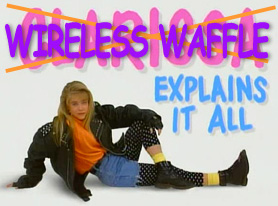 Conduct a web-search for topics relating to 5G and on many occasions the answers which get returned are nothing to do with the next generation of mobile services, but relate to 5 GHz, which is one of the frequency bands used for WiFi (as well as several other technologies). It seems that both terms being of a wireless nature, those clever search engines are yet to be able to fully distinguish between them.
Conduct a web-search for topics relating to 5G and on many occasions the answers which get returned are nothing to do with the next generation of mobile services, but relate to 5 GHz, which is one of the frequency bands used for WiFi (as well as several other technologies). It seems that both terms being of a wireless nature, those clever search engines are yet to be able to fully distinguish between them.But there is more... If that isn't confusing enough, there's also a technology known as G5 which is designed to perform the job of allowing vehicles to communicate with each other, known as vehicle-to-vehicle (V2V) communications, and with infrastructure (such as traffic lights) known as V2I. And to really throw the cat amongst the pigeons, the frequency band used for G5 is 5 GHz (5850 - 5929 MHz). Got that?
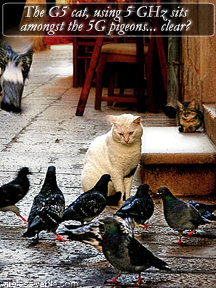 So, just to be really clear and helpful in exactly the way that Wireless Waffle always isn't, here are some bullet points which don't make everything far more translucent:
So, just to be really clear and helpful in exactly the way that Wireless Waffle always isn't, here are some bullet points which don't make everything far more translucent:- 5G is the term used for the next generation of mobile technologies which will follow after 4G (LTE). The technology involved is also known as New Radio (NR).
- 5 GHz is a range of radio frequencies often considered as being 5150 - 5925 MHz, which are used by a wide variety of applications including WiFi, 4G (including LTE-U, LTE-LAA and MulteFire) and G5.
- G5 is a vehicle communication technology designed to enable Intelligent Transport Systems (ITS) such as autonomous vehicles.
add comment
( 425 views )
| permalink
| 



 ( 3 / 61478 )
( 3 / 61478 )




 ( 3 / 61478 )
( 3 / 61478 )
Thursday 21 February, 2019, 08:53 - 5G, Spectrum Management, Much Ado About Nothing
Posted by Administrator
Back in December of 2016, the UK Government's National Infrastructure Commission published its 'Connected Future' report. It recognised that:Posted by Administrator
government must take responsibility to secure our digital future ... Government must ensure we have the infrastructure in place to deliver 5G
Amongst the various proposals in the report, many are based on the recognition that 5G will require access to orders of magnitudes more base station sites than are currently deployed for 4G.
This makes a lot of sense. Local planning restrictions already hamper the roll-out of mobile services, not just because local councils think that cell sites are ugly, or even that they damage the environment or health, but the application procedure to get permission to install a site varies wildly from one council to another. Simplifying, harmonising and streamlining the process is essential if the UK, or indeed any country, is going to benefit from whatever it is that 5G is going to offer.
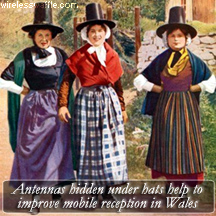 It seems rather short-sighted then, that the Welsh Government is still pondering a change to what are know as Permitted Development Rights (PDR) to allow mobile operators to build masts with a height of 25 metres (82 feet) with reduced planning requirements. At present, in Wales, operators are only allowed to extend the height of their masts to 15 metres (50 feet), whereas in the rest of the UK, the limit is 25 metres.
It seems rather short-sighted then, that the Welsh Government is still pondering a change to what are know as Permitted Development Rights (PDR) to allow mobile operators to build masts with a height of 25 metres (82 feet) with reduced planning requirements. At present, in Wales, operators are only allowed to extend the height of their masts to 15 metres (50 feet), whereas in the rest of the UK, the limit is 25 metres. Wireless Waffle has previously discussed the relative merits of increasing transmitter power compared to increasing antenna height and demonstrated the importance of antenna height. In an area such as Wales where the difficulty in providing coverage is exacerbated by the hilly terrain, and where a large number of mobile 'not-spots' exist, antenna height is of even greater importance. The reluctance to increase the permitted tower height comes in stark contrast to a previous move by the Welsh Government to invest £150 million in trying to provide coverage in these not-spots.
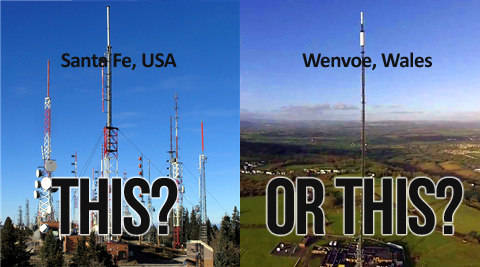
There is no doubt a fear that higher masts will make the countryside look ugly or cluttered, but the counter-balancing effect is that taller masts, means fewer masts. Imagine how many TV transmitter towers there would need to be if their height was limited to 15 metres. If Wales is to rise out of the valleys in terms of mobile coverage, the Welsh Government needs to act quickly, i.e. before 5G comes along, to ensure that the existing not-spot problems are not further heightened (see what we did there?)
As they say in Wales: "Nid yw tegell llawn caws yn cael ei ddefnyddio i ffôn symudol gyda chalon wedi'i dorri."
No sooner has 2019 begun than the 5G hype wagon has been set off over the dusty plains being drawn by a load of dog-eared donkeys with lazy, do-nothing yokels riding on the back of it. This week it is the turn of US mobile giant AT&T who have somehow convinced Apple to update the firmware in their iPhone to show '5G' (or more precisely '5G E') as the network to which it is connected.
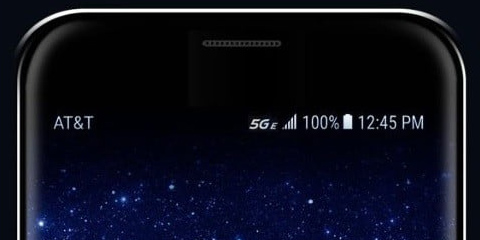
But the network isn't 5G, it's 4G. AT&T don't have a 5G mobile network.
A while ago, Wireless Waffle attempted to demystify the various network type indicators that are shown on mobile phones. If this can be fudged by mobile operators or mobile handset manufacturers, then expect to see lots of new '5G' services sprouting up any time soon. What will the operators then do when they actually launch 5G? 6G here we come...!

But the network isn't 5G, it's 4G. AT&T don't have a 5G mobile network.
A while ago, Wireless Waffle attempted to demystify the various network type indicators that are shown on mobile phones. If this can be fudged by mobile operators or mobile handset manufacturers, then expect to see lots of new '5G' services sprouting up any time soon. What will the operators then do when they actually launch 5G? 6G here we come...!
 2018 was hopefully the year in which 5G hype peaked. Lots of mobile operators and equipment manufacturers were desperate to jump on the band-wagon and proclaim their plans to launch or operate 5G services or devices to be the first out of the running blocks. The simple fact, however, was that the 5G standard was delayed for 3 months until June 2019, and as of yet, there is no internationally agreed spectrum for 5G services.
2018 was hopefully the year in which 5G hype peaked. Lots of mobile operators and equipment manufacturers were desperate to jump on the band-wagon and proclaim their plans to launch or operate 5G services or devices to be the first out of the running blocks. The simple fact, however, was that the 5G standard was delayed for 3 months until June 2019, and as of yet, there is no internationally agreed spectrum for 5G services.2019 will hopefully be the year in which some of the hype begins to melt, and reality sets in. Prime amongst this will be the decisions taken at the ITU's World Radiocommunications Conference (WRC-19) which is due to take place in Sharm El-Sheikh in Egypt in November. One of the Agenda Items for the confernence, if not the most important agenda item of the conference, is number 1.13, whose snappy title is:
To consider identification of frequency bands for the future development of International Mobile Telecommunications (IMT), including possible additional allocations to the mobile service on a primary basis, in accordance with Resolution 238 (WRC-15).
 IMT is the ITU's terminology for commercial mobile communications and there are actually three flavours, IMT (2G and 3G), IMT-Advanced (4G) and IMT-2020 (5G). Before any radio spectrum can be formally used for IMT services of any kind, there are two prerequisites. Firstly the spectrum must have a 'mobile' allocation in the country in which it is to be used. Such an allocation will be found in the country's national frequency allocation plan. And in theory, if it is to be used for mobile services, it should also have been identified by the ITU as spectrum for IMT. All of the current mobile bands (e.g. 700, 800, 900, 1800, 2100, 2600 MHz) are in pieces of spectrum that have this identification.
IMT is the ITU's terminology for commercial mobile communications and there are actually three flavours, IMT (2G and 3G), IMT-Advanced (4G) and IMT-2020 (5G). Before any radio spectrum can be formally used for IMT services of any kind, there are two prerequisites. Firstly the spectrum must have a 'mobile' allocation in the country in which it is to be used. Such an allocation will be found in the country's national frequency allocation plan. And in theory, if it is to be used for mobile services, it should also have been identified by the ITU as spectrum for IMT. All of the current mobile bands (e.g. 700, 800, 900, 1800, 2100, 2600 MHz) are in pieces of spectrum that have this identification.The Agenda Item is investigating a wide range of frequency bands ranging from 24.25 to 86 GHz.
| Frequency Range | Amount of Spectrum |
|---|---|
| 24.25 - 27.5 GHz | 3.25 GHz |
| 31.8 - 33.4 GHz | 1.6 GHz |
| 37.0 - 43.5 GHz | 6.5 GHz |
| 45.5 - 50.2 GHz | 4.7 GHz |
| 50.4 - 52.6 GHz | 2.2 GHz |
| 66.0 - 76.0 GHz | 10.0 GHz |
| 81.0 - 86.0 GHz | 5.0 GHz |
| TOTAL | 33.25 GHz |
In total an increadible 33 GHz of new spectrum is being examined, which is in the order of 30 times more than has been identified as of today. Of this, it seems likely that something in the region of 20 GHz of spectrum will be identified for IMT. However, the waters are already being muddied by the organisations that manufacture mobile equipment and devices, and by one or two influential countries (e.g. the USA, Japan and China), and the nascent 5G standard includes the use of spectrum that is not part of the Agenda Item's studies.
In particular, the US, Japan and South Korea and others are proposing the use of a 28 GHz band (27.5 - 29.5 GHz) and South Korea, Japan and China are considering the use of a 4 GHz band (4.4 - 5.0 GHz), both bands, as it happens, being currently used for commercial satellite services. As these bands are not on the agenda for WRC-19, in theory they can not be identified for IMT meaning that they would be 'non-harmonised' bands. But in today's fast moving mobile industry, what really constitutes 'harmonised'? Does it mean that it has gone through the laborious 4 year ITU conference cycle, or does it mean that enough countries with sufficiently large populations to encourage economies of scale in manufacturing have got together and agreed a way forward.
 Many question the validity of the ITU process, saying that it is outdated, lethargic and even irrelevant. Some are even threatening to withdraw themselves, and their funding, from the organisation. That being said, it remains the process that most of the almost 200 members of the United Nations turn to, to help them align their use of the radio spectrum with the rest of the planet.
Many question the validity of the ITU process, saying that it is outdated, lethargic and even irrelevant. Some are even threatening to withdraw themselves, and their funding, from the organisation. That being said, it remains the process that most of the almost 200 members of the United Nations turn to, to help them align their use of the radio spectrum with the rest of the planet.The forthcoming WRC therefore, and the associated decisions on the frequency bands to use for 5G, stands to be fascinating, both from the perspective of the sheer amount of new mobile spectrum that could be available following the conference, and whether or not the rogue nations will be able to twist enough arms to get their positions ratified, or will just storm out of the room in a huff. Wireless Waffle, will, as always, keep you posted.


